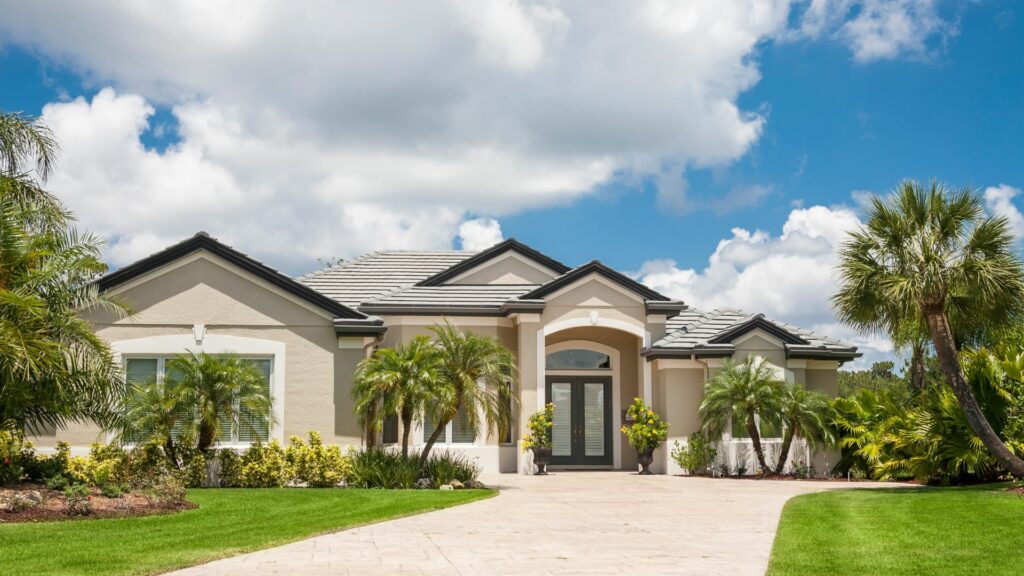What comes to mind when you think about palm trees? Tall trunks with long, feathery fronds and a romantic sunset in the background. In reality, there are more than 2,500 palm species, with at least one type suitable for any imaginable landscaping project. When landscaping with palms, knowing what to plant around them can change a simple garden bed into a verdant masterpiece.
When landscaping with palms, there are several factors to consider before deciding on what to plant around them. Choose your species first, then select companion plants with similar water and feeding requirements, with varying colors, textures, and heights to accentuate your landscaping design.
As majestic as your palm trees may be, they can be so much more when accompanied by other beautiful plants. But if you’re a novice landscaper, where do you begin? Once you’ve chosen the palms to take center stage in your design, read on for essential tips on what to plant around them to create that breathtaking wow factor.
Tips on Landscaping with Palm Trees

Palm trees are the perfect focal point of a tropical garden, and they grow well in the northern hemisphere, providing temperatures stay above 25°F. This means they are suitable for USDA hardiness zones 6 to 12.
Rather than consulting an endless list of possible companion plants for palm-centered landscaping, it’s easier to start by learning how to choose suitable types of plants.
Choose Native Companions For Palm Trees
When landscaping with palms, first consider companion plants native to your area. They will grow easily and require the least amount of maintenance. Native plants usually rely solely on rainfall, even in dry climates, although they will need extra watering when you plant them to get their root systems firmly established.
Another advantage of native plants is that they can tolerate high summer temperatures, winter lows, and low humidity. Additionally, these plants are usually more resistant to insect pests than those not indigenous to the area.
Hardiness Matters
When choosing plants to plant around your palm trees, you may select them for their colors and texture rather than because they are native to your area. In that case, choosing plants that thrive in the palm’s hardiness zones is essential.
Consider Sun and Shade Requirements
Before planting companions for your palm trees, consider their sun and shade requirements. Different palm trees cast varying degrees of shade, so any companions must have at least partial shade tolerance.
Vary Colors, Textures, and Heights
Many focal-point palms grow to fair heights. To create a lush, full effect, incorporate ground cover, an understory, and a midstory. The understory consists of plants growing above the ground, while the midstory refers to those taller than the understory but lower than the canopy.
When sculpting a tropical landscape, greenery in various shades can be very attractive, and there are endless varieties of shrubs that will accentuate your palms. But adding bright snaps of color can create an Eden-like paradise, so it’s worth considering flowering plants to paint your perfect garden scene. Tropical and subtropical plants blend well with palm trees.
You can also vary textures by mixing palm trees with thin, needle-like leaves with companion plants with small, round leaves or large, broad foliage. Shrubs with dark, shiny leaves could also complement palms with hairy trunks, like the Windmill palm. Contrasting colors and textures can make stunning, eye-catching landscapes.
Plant Evergreens For Privacy
When landscaping with palms in an urban garden, choose evergreen companion plants for privacy. You don’t want gaps in your vegetation when deciduous trees shed their foliage.
What To Plant Around Palm Trees
Keeping all the above factors in mind, you can plant any of the following plants around your palm trees to sculpt a lush tropical scene.
Include a Colorful Bougainvillea
Bougainvilleas are the epitome of tropical vegetation and come in myriad colors bright enough to cheer up any tired garden space.
The colored parts are not flowers but leaf bracts that surround the flowers. Bougainvilleas are versatile, drought-resistant, and can bloom all year round under optimal conditions. You can train it as a vine or allow it to grow as a shrub or tree as part of the midstory.
Soft Tree Ferns Accentuate Palm Tree Landscapes
Dicksonia Antarctica is evergreen and grows well with good afternoon or morning light. They can reach a height of four yards, making them beautiful candidates for the midstory. Ensure there is enough space to grow beneath or around your palm tree for this companion.
Jasminum Officinale Breaks The Bare Space
The trunks and areas around palm trees often look bare and dull. Jasminum officinale, or the common jasmine, can create a stunning, fragrant filler for this space. The plant is versatile and hardy. It can act as ground cover or grow as a vine. It is suitable for USDA zones 7-11.
Bromeliads Need Nothing But Air
Bromeliads are excellent companions for plants. They have colorful sword-shaped blooms. These plants attach themselves to the bark of their host palm trees but are not parasitic. They draw their nutrients from the air. They require no maintenance and can tolerate full shade. For a different effect, you can grow them in the crevice of a rock at the base of your palm tree.
Bird of Paradise Perfectly Complements Palm Trees
Another hardy tropical plant suitable as a palm tree companion is the Bird of Paradise (Strelitzia reginae). It is a low-maintenance shrub with a stunning orange bloom resembling a bird in flight and has thick, broad leaves. It will complement palm trees with thin pinnate foliage. It loves bright but indirect sunlight and moist, well-draining soil and flourishes in USDA zones 10 and 11.
Other Plants To Plant Around Palm Trees
Beyond the plants discussed above, there are thousands that make excellent companions to palm trees. Others to consider include:
- Ferns as part of the understory/ground cover
- Cycads
- Caladiums
- Crotons
- Boxwoods
- Leopard plants as ground cover
Final Thoughts
With more than 2,500 species, you can create any number of glorious palm tree landscapes, and there are as many plants you can plant around them to sculpt your garden masterpiece. Selecting native plants with similar hardiness to the palms and those that add color, texture, and differing heights will leave you with a tranquil, exotic oasis in your own backyard.

